Abstract
Protected areas are an effective mechanism usually supported by a statute to conserve and protect wildlife-rich areas worldwide. Such extensive external management needs elaborate planning, regular monitoring, and periodic assessment of results. Thus, management effectiveness evaluation (MEE) has emerged as one of the major tools for quantifying the performance of any protected area globally since 2006. India has successfully conducted a complete round of management effectiveness evaluation of all its terrestrial protected areas (except conservation reserves and community reserves), with 25 such areas already undergoing a repeat assessment. Simultaneously, India biennially carries out a country-wide status of forest cover in all its states and union territories. This study has correlated the trend in change in forest cover for the states that contain those 25 repeat evaluated protected areas with their change in MEE scores over the same period. Our study found a positive correlation between the change in forest cover and the change in management effectiveness score from 2005–2006 to 2018–2019. Owing to increased protection regimes in the PAs including the degraded areas if they make part of such areas, the habitat often shows recovery. Effective habitat conservation is thus intertwined with the monitoring and preservation of the wildlife populations in the protected areas; therefore, reduction in forest cover equally impacts the management scores. However, in states where the loss in forest cover has been reported, more protected areas need to be assessed to plan complementary strategies for both habitat and species conservation.
1. Introduction
India, a mega biodiversity country with only 2.4% of the world’s land area, accounts for 11.2% of the world’s floral and 6.7% of known faunal species, which includes over 48,655 species of plants and 100,693 species of animals [1]. A biogeographically representative and effectively managed Protected Area (PA) network is considered the most important means of in situ conservation of this unique biodiversity, and, in India, it is spread over 10 biogeographic zones of the country [2]. The country has one of the world’s most extensive networks of officially recognized PAs. Protected Areas (PAs) play the multifaceted role of conserving biodiversity, implementing various environmental agreements [3,4], and providing ecosystem services like climate change mitigation, and protection against natural disasters, and, lastly, they are inherently correlated with indigenous communities in terms of both livelihood and cultures [5,6]. India is developing rapidly and, presently, it is one of the topmost densely populated countries globally; understandably, creating Protected Areas (PAs), which have legally established inviolate status, is no mean feat. The PAs are facing challenges from the shrinkage of natural resources and anthropogenic pressures at a non-stop pace [7]. Such havoc challenges inevitably lead to changes in ecology, animal behavior, and conservation status of several species, which need critical assessment and regular monitoring. After such assessment and monitoring, the main task befalls on the management aspect, as interventions like reducing the anthropogenic pressures and implementing effective protection need planning ahead of time. Therefore, the management practices require periodic evaluation to see their applicability to changing resource use patterns and ensure the support of local communities in conservation programs.
Adequate protection of an area is not ensured simply by declaring it a PA; globally, there is growing concern that many protected areas are not achieving their objectives and are unable to implement actions that are required to improve their effectiveness [8]. Ideal PA management is inclusive of periodic assessment of effectiveness and modification of the inputs accordingly. Assessment is a platform that brings local communities and government machinery together, helping towards better resource partitioning and appropriate threat response [9].
Regular monitoring of the improvement in PA management over time and the associated issues of on-ground management is a crucial benchmark for Aichi Target 2020 and the overall delivery of the Convention on Biological Diversity (CBD) Strategic Plan, along with the post-2020 Global Biodiversity Framework. Under the CBD, along with Aichi Target 11, member countries are implementing the Program of Work for Protected Areas (PoWPAs), which includes 16 goals under four program elements. India submitted its Action Plan on PoWPAs to the CBD secretariat in 2012. In similar line with 20 Global Aichi Targets, India has developed 12 National Biodiversity Targets (NBTs). The NBT6 is about PA management, which is governed by the Wildlife (Protection) Act of 1972.
Management effectiveness evaluation (MEE) is used as a tool globally to evaluate the performance of PAs. The growing interest in the effectiveness of management of protected areas can be traced through the emergence of the topic at the decadal World Parks Congresses, as after the fourth World Parks Congress in Caracas in 1992 [10], several methodologies for assessing the management effectiveness of protected areas were developed, primarily in Central and South America [11,12,13] and Australia [14]. In 1996, the IUCN World Commission on Protected Areas (WCPA) commenced work on a framework and guidelines for assessing the management effectiveness of protected areas, which led to the first edition of the IUCN guidelines for Evaluating Effectiveness, a framework consisting of six elements designed for assessing the management of protected areas [15], first designed in 2000, with a revision in 2006 [9], and which has since formed the foundation for most of the protected area evaluation systems developed and applied around the world.
According to the global database of PAME (Protected Area Management Effectiveness) of the CBD Programme of Work on PAs, only 42 countries have implemented MEEs in at least 60% of their PAs (21,743 PAs), and the results indicate that the average PAME score, for all assessed PAs, is 52% [6,16]. Management effectiveness assessments have been conducted across 18.29% of the area covered by protected areas globally, which is much below the 60% target set by the CBD [6].
Protected area management effectiveness is also a requirement of the convention on biological diversity (Goal 4.2: To evaluate and improve the effectiveness of protected area management). In the last two decades, India has adopted the MEE framework and has made significant efforts to institutionalize the process of MEE of PAs. The process of evaluation of National Parks (NPs) and Wildlife Sanctuaries (WLSs) through MEE was initiated in 2006 and continues to date, with the latest cycle report published in 2021 [17].
Biodiversity conservation in India has been governed and managed by two major wings of the forest department under the state governments, the territorial forest wing and the wildlife wing. The Indian Forest Act (1927) provides the major legal backing for the protection and management of forests in terms of Reserve Forest, Protected Forest, and Village Forest, whereas the Wildlife (Protection) Act of 1972 is the legislation for the conservation and management of wildlife-rich areas through the declaration of Protected Areas in terms of National Parks, Wildlife Sanctuaries, Conservation Reserves and Community Reserves. PAs in India are mostly managed through plans prepared as per guidelines [18], though the same has not been officially adopted by the government. The biennial forest cover analysis does not consider individual PAs, but the total forest cover of the region (in this case, the country’s states). In India, every alternate year, the State of Forest Report is released by the Government of India [19,20], which depicts a holistic picture of change in forest cover across the country both inside and outside recognized forest areas (Figure 1 shows a map of India with forest cover as in 2019). The present study is aimed toward the hypothesis that planned forest management is directly linked to the total growth in the forest cover in PAs, and this work evaluates whether the management effectiveness of any PA can be an independent indicator of change in the status of forest cover in the region in the equivalent period of time. Globally, forest management and PA management are generally considered parallel sectors and not a univalent one, and our study tries to highlight the intricate interdependency of PA management towards forest growth and maintenance.
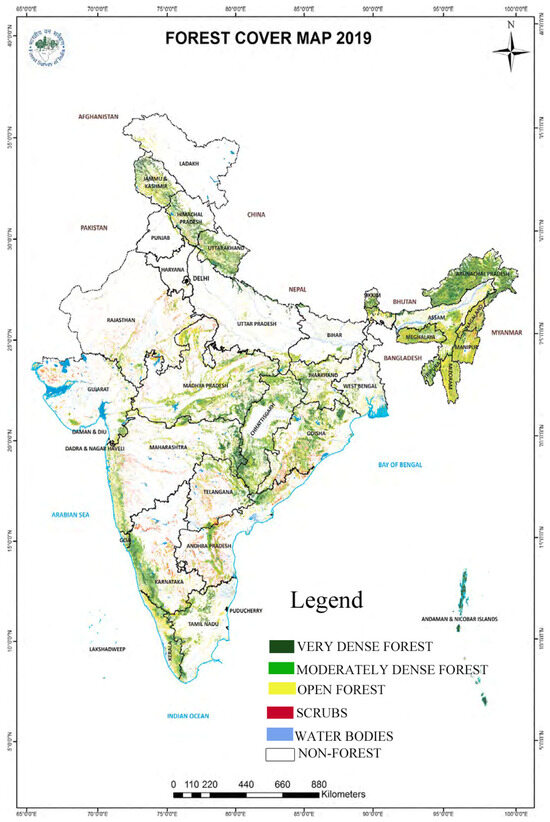
Figure 1.
Map of India showing forest cover as in 2019 [19].
2. Indian Protected Areas
The PA network of India covers 5.26% of the geographic area of the country. The network of PAs represents all the country’s 10 biogeographic zones [3]. Legally, India has designated four categories of PAs: National Parks, Wildlife Sanctuary, Conservation Reserve and Community Reserve. As of 31 July 2023, a total of 1022 protected areas have been established in India, which include 106 national parks, 573 wildlife sanctuaries, 123 conservation reserves, and 220 community reserves [21].
The protected areas can be broadly divided into two subcategories of strict protection with complete prohibition of any unpermitted activities vs. conservation through sustainable use of resources for community subsistence. The management of the first category is fully government-controlled, whereas the management of the second category is largely carried out through the involvement of the local community. National Parks and Wildlife Sanctuaries fall under the first category, whereas Conservation Reserves and Community Reserves fall under the second category. Both these categories can therefore be compared to IUCN categories as elaborated in Table 1. By 2019–2020, the MEE exercise had been completed for all PAs of the first category, i.e., National Parks and Sanctuaries, except coastal/marine National Parks and Sanctuaries of Andaman and Nicobar Islands (Coastal/Marine National Parks and Sanctuaries are National Parks and Sanctuaries which protect a coastal or marine habitat). The Tiger Reserves are a special type of conservation area dedicated completely to tiger-specific protection; the core areas of Tiger Reserves are usually legally notified National Parks and Sanctuaries and are evaluated through a separate MEE exercise, and a pilot study of MEE of coastal/marine PAs was initiated in 2021–2022 in India.

Table 1.
The four protected area categories in India and their comparison with equivalent category of IUCN.
3. Management Effectiveness and State of Forest
An MEE has only been conducted in NP and WLS out of the four PA categories in India. The MEE process was initiated by the Government of India in 2006 and has completed an evaluation of 442 National Parks and Wildlife Sanctuaries from 2006 to 2019 in four phases, excluding the Conservation Reserves, Community Reserves, Coastal and Marine parks of Andaman and Nicobar Islands and parks/wildlife sanctuaries falling under the Tiger Reserves of the country (as detailed in Table 2).

Table 2.
Total number of protected areas evaluated through the MEE exercise in India from 2006 to 2019 in four phases.
The IUCN-World Commission on Protected Areas (WCPAs) framework of MEE has been used in the MEE exercise with appropriate modifications. All six indicators (context, planning, inputs, processes, output, and outcomes) are used with a series of specific questions pertaining to each category. Each indicator has a value assigned to the number of questions asked. Marking is then provided out of the total value the indicator carries; planning, input, and output have maximum values assigned as these parameters are considered key factors behind management performance (Table 3). While analyzing the respective average scores of the six elements of the MEE process for all the 25 repeat PAs, we found that, in general, the highest score was received by planning, followed by inputs (Table 3).

Table 3.
Comparative analysis of the score of the indicators in the 2018–2019 MEE cycle. Each indicator has a value assigned to the number of questions asked. Marking is then provided out of the total value the indicators carry; planning, input, and output have maximum values assigned as these parameters are considered key factors behind management performance [22].
Therefore, it can be seen that all territorial PAs have already been covered once under the MEE exercise. After the completion of the evaluation of all PAs in four phases, a repeat cycle of evaluation was taken up in 2018–2019 for 25 such PAs which were evaluated initially in 2005–2006. The change in MEE score was analyzed linearly between the two cycles (Table 4).

Table 4.
Comparison of management performance of PAs as per the MEE score of 2006 and 2018–2019. Only those PAs which were repeat-evaluated were considered.
In the states of Manipur, Meghalaya, and Tripura, only a single PA was registered in 2005, which was re-evaluated in 2019. Therefore, these three PAs solely represent their state, whereas in the case of other PAs, they represent all the other PAs as well for the sake of this study. The data were taken from the MoEFCC-WII (Ministry of Environment Forests & Climate Change/Wildlife Institute of India) MEE reports of the concerned years; the authors were involved in the 2018–2019 report [22,23]. Figure 2 shows the 146 PAs evaluated in 2018–2019 cycle.

Figure 2.
Map of India showing 146 PAs evaluated in 2018–2019 cycle [22].
4. Methodology
An individual PA is not assessed for forest cover or tree outside forest cover in India in the biennial assessment of forest cover. The assessments are carried out at the state level, and each state has multiple PAs within its territorial jurisdiction. Therefore, the forest cover change in 21 states covering the 25 repeat cycle PAs was analyzed in this study. The forest cover between 2006 and 2019 (Table 5) was analyzed for this purpose. The state of Andhra Pradesh was bifurcated in 2014 into two states, Andhra Pradesh and Telangana. Therefore, the 2019 forest cover was taken by combining data from both states, as the 2005 data represented the unified-state data.

Table 5.
Change in total forest cover of India as compared between 2006 and 2019 data (source: State of Forest Report, Government of India); i.e., the years for which MEE scores have been analyzed.
Simultaneously, the respective average scores of the six elements of the MEE process were compared and analyzed for all the 25 repeat PAs (Table 4). This was carried out to understand the priority sector of field-level conservation from the PA managers’ perspective and whether the elements themselves have any intercorrelation.
The change in forest cover was categorized into three sections, high increase in forest cover (>1000 sq. km.), low increase in forest cover (<1000 sq. km.), and decrease in forest cover. The Kruskal–Wallis test was run to understand the effect of the change in forest cover on each element of the MEE repeat cycle for all the 25 PAs.
All analytical processes were performed using the R software (R 4.2.1). A Spearman’s rank correlation test was performed to check the relationship between the pairs of indicators and one-way ANOVA was carried out to check the significance of the difference between the overall score of two cycles of evaluation. As the variables are not normally distributed and do not have equal variance, Spearman’s test was conducted to evaluate whether the increase in one variable causes an increase in the other variable, though the increase is not consistent.
5. Results
Out of a total of 25 of the repeat PAs, 18 PAs showed considerable performance improvements, five PAs showed a negative trend, and two PAs showed no change in score. One-way ANOVA suggested a significant difference (p < 0.05) between the cycles of evaluation as p = 0.04517.
Furthermore, the change in MEE score was analyzed against the change in forest cover between 2005 and 2019. In 2019, the PA network covered 5.26% of India’s geographical area, whereas the recorded forest area was 23.58%. Therefore, assuming that all the PAs are in forested areas, the PAs cover only 22.30% of the total forested area of India. The Spearman’s rank correlation plot highlighted the fact that there is a strong correlation (p = 0.25) between the change in MEE scores with the change in forest cover of the concerned region (Figure 3). Simply, it is observed that growth in forest cover was observed wherever there was a considerable increase in MEE score between the two cycles.
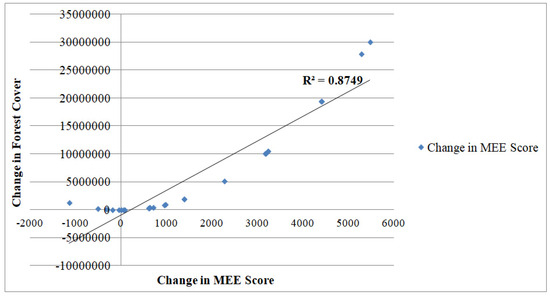
Figure 3.
Change in MEE score with comparison to change in forest cover (sq. km.).
Subsequently, we analyzed whether each element’s performance can be linked to the change in forest cover. It was found that planning, inputs, and outcomes are all positively correlated with change in forest cover (r = 0.9355, 0.9372, and 0.9371, respectively) (Figure 4).
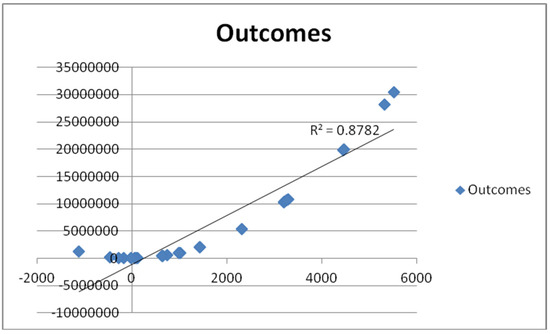
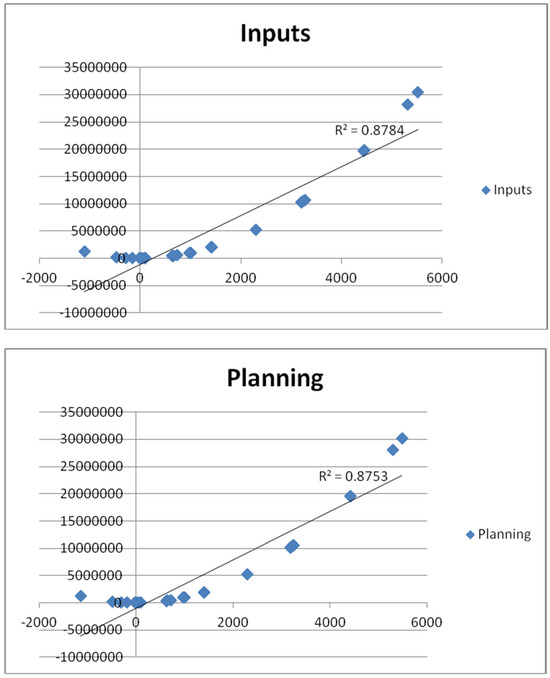
Figure 4.
Asserting the trend in changes in the score of three main MEE elements with change in forest cover.
It was found that the overall MEE score after the repeat cycle is not significantly different for the three categories of forest cover change. High-forest-cover-change states have an average of 66.35% (SD = 20.82), and low-forest—change states have an average of 66.47% (SD = 12.48); however, states with a decrease in forest cover have an average of 62.06% (SD = 13.56) in MEE score in the 2019 cycle. In the last category, however, two PAs showed a reduction in MEE score from the 2005 score, one PA had an unchanged score, and one PA showed an increase in the MEE score from the 2005 score. Therefore, a 50% reduction in MEE score was witnessed when there was a reduction in forest cover. In the other two cases, it was the two states Manipur and Tripura, where only one PA each from the state was evaluated, unlike others. Therefore, there can be a chance of reduction in MEE score in these cases as well based on more PAs being evaluated.
Considering the individual elements of the MEE process and the three categories of change in forest cover, the level of significance found between the changes in MEE values and the types of changes in forest cover, the Kruskal–Wallis test result is H = 0.78 with a p value of 0.67 (Figure 5).
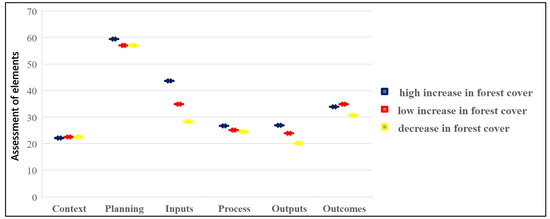
Figure 5.
Results for each MEE element in the forest cover change categories. There is a significant correlation in input between areas with high increases and decreases in forest cover.
6. Discussion
In the MEE process, scoring was carried out based on the field observations and evidence provided by the PA management authorities. Hockings et al. (2006) provided a comprehensive framework for evaluating the management effectiveness of protected areas, which includes assessing ecological indicators such as forest cover [9].
The analyzed PAs have a large range of management effectiveness considering their MEE scores are range from the lowest at 43.33 to the highest at 84.17. Therefore, this group of PAs is a well-represented sample to understand the field level management variation, as well as concerning the change in forest cover of the respective states. The change in forest cover is influenced by many territorial forest areas owing to various management practices and anthropogenic pressures, viz., dependencies and infrastructural development. External factors like the conversion of forest land can have a considerable impact on forest cover. This practical view has been kept in mind while interpreting the data as well. Globally, for example, in the Brazilian Amazon, studies have been carried out to correlate management effectiveness scores with changes in forest cover, highlighting the importance of effective management in slowing deforestation [24].
In the results, we have seen that among the six elements, the planning process in total obtains the comparative highest score in MEE; however, the actual input is more correlated with the change in forest cover. This fact needs to be taken into consideration as it indicates that the MEE process is putting more focus on documentary evaluation (which portrays the planning part) than complete field inspection (i.e., the input part). Very often, field managers make instant decisions to deal with a situation within their discretionary powers which may not be later documented on paper; therefore, actual actions are shadowed by documents, which is the main item evaluated in the MEE. Also, field observations can only help to evaluate the result, that, is output and outcomes, but the cause of the result, i.e., the input, is not being given due importance, as evidenced from the scores. However, it is also a fact that assessing the planning is easier because of the readily available documents, whereas annual prescriptions and inputs based on the local condition are mostly not documented and therefore harder to assess optimally, thus bringing in subjectivity.
The results have also shown that MEE scores improved when there was an increase in forest cover; it can therefore be safely stated that the improvement in MEE score is influenced by better forest management holistically. Thus, the overall quality of natural resource management in a state is reflected both in the forest cover as well as in PA management.
Holistically, this study has shown a positive relationship between management practices and tangible results on the ground. Species conservation is impossible without habitat and forest conservation, which is evident from the results obtained. In India, although PA management is considered a separate task from general forest management, the conservation efforts made in any PA contribute to the broader conservation gains of an increase in forest cover, as shown by our study. This result is also indicative of the effort that PA managers on the field are making with the concept of forestry management as a whole. The change in forest cover occurs on the ground with site-specific prescriptions and field action and vice versa. It is also important that the same agency, i.e., the state government, through the forest department, manages the PAs as well as the forests as a whole since the two cannot be separated ecologically and often complement each other. The results of PA management and forest cover change are reflections of the efficiency of the same agency and thus the correlation is expected. Joppa and Pfaff (2011) also conducted a global analysis of forest cover in protected areas, providing evidence of the effectiveness of different management strategies and their impact on forest conservation [25].
Therefore, it can be safely stated that the planning process is mostly an individual-oriented action, as it cannot be taken for granted that each management regime will adopt previous practices and continue the same planning. Similarly, altering field conditions, ever-changing climatic factors, and sudden emergencies like disaster responses can always cause significant deviation in the correlation found. However, this study attempted to establish the hypothesis of a direct linkage between MEE score and forest cover changes and can be considered as base data for further analysis while incorporating many external variable factors. A global study led by Leverington et al. (2008) linked management effectiveness evaluations to biodiversity outcomes, including changes in forest cover. It provided empirical data on how improved management practices can lead to better forest conservation [26].
India is a mega biodiversity country; the wide plethora of wildlife cannot be managed in isolation without managing the forest ecosystem in the larger landscape in the ecological continuum. Any change in the forest, be it a decrease in forest cover or an increase in grassland area, has a direct impact on the fauna utilizing that specific habitat. Protected areas are not simple enclosures of any wild animals with set boundaries; they are forest land and forest ecosystem, being specially managed with interventions specific to the key species occupying that area. Any input in wildlife management also involves forest management, and through the results, it is established that all inputs and planning changed with changing forest cover. In recent times, global studies conducted by Geldman et al. (2019) assessed the global effectiveness of protected areas, showing that higher management effectiveness scores are associated with lower rates of forest cover loss [27].
In conclusion, it can be opined that India is conserving and managing its biodiversity as a whole and not in PAs as islands. Thus, conservation is taking effect at the landscape level. However, further intricate studies linking each PA with its specific forest cover type and the respective change in forest cover are required to uphold a strong conservation practice model to the global community.
Author Contributions
Conceptualization, M.S. and D.M.; methodology, M.S.; software, M.S.; validation, M.S. and D.M.; formal analysis, M.S.; investigation, M.S. and D.M.; resources, M.S. and D.M.; data curation, M.S. and D.M.; writing—original draft preparation, M.S.; writing—review and editing, M.S. and D.M.; visualization, M.S.; supervision, D.M.; project administration, M.S. and D.M. All authors have read and agreed to the published version of the manuscript.
Funding
This research received no external funding.
Institutional Review Board Statement
Not applicable.
Informed Consent Statement
Not applicable.
Data Availability Statement
Data is contained within the article.
Conflicts of Interest
The authors declare no conflict of interest.
References
- CBD, India’s 6th National Report, 2018. Available online: https://chm.cbd.int/database/record?documentID=241351&_gl=1*k8vq0g*_ga*MTE3NzQ4Nzk4Mi4xNjkwNjk4Mzkz*_ga_7S1TPRE7F5*MTcyNDU4ODA2Ny4yLjEuMTcyNDU4ODA5OC4yOS4wLjA (accessed on 8 September 2022).
- Rodgers, W.A.; Panwar, H.S.; Mathur, V.B. Wildlife Protected Areas in India: A Review (Executive Summary); Wildlife Institute of India: Dehradun, India, 2002; pp. 1–51. [Google Scholar]
- Stoll-Kleemann, S. Evaluation of management effectiveness in protected areas: Methodologies and results. Basic Appl. Ecol. 2010, 11, 377–382. [Google Scholar] [CrossRef]
- Bongaarts, J. IPBES, 2019. Summary for Policymakers of the Global Assessment Report on Biodiversity and Ecosystem Services of the Intergovernmental Science-Policy Platform on Biodiversity and Ecosystem Services; Wiley: Hoboken, NJ, USA, 2019. [Google Scholar]
- Hockings, M. Systems for assessing the effectiveness of management in protected areas. BioScience 2003, 53, 823–832. [Google Scholar]
- UNEP-WCMC and IUCN. Protected Planet Report 2020; UNEP-WCMC and IUCN: Cambridge, UK, 2021. [Google Scholar]
- Mathur, V.B.; Ansari, N.A.; Onial, M. Protected areas management in India: Challenges and way ahead. Spec. Issue Environ. 2019, 18, 101. [Google Scholar]
- Borrini-Feyerabend, G.; Johnston, J.; Pansky, D. Governance of protected areas. In Managing Protected Areas; Routledge: London, UK, 2012; pp. 146–175. [Google Scholar]
- Hockings, M. Evaluating Effectiveness: A Framework for Assessing Management Effectiveness of Protected Areas; IUCN: Gland, Switzerland, 2006. [Google Scholar]
- Hockings, M.; Leverington, F.; Cook, C. Protected area management effectiveness. In Protected Area Governance and Management; IPBES: Bonn, Germany, 2015; pp. 889–928. [Google Scholar]
- Courrau, J. Strategy for Monitoring the Management of Protected Areas in Central America; Programa Ambiental Regional para Centroamérica (PROARCA), Central American Protected Areas System (CAPAS), Comisión Centroamericana de Ambiente y Desarrollo (CCAD), United States Agency for International Development (USAID). 1999. Available online: https://www.birdlist.org/downloads/monitoring/bdd_efectividad_de_manejo_manual.pdf (accessed on 8 September 2022).
- De Faria, H. Elaboración de un Procedimiento para Medir la Efectividad de Manejo de Áreas Silvestres Protegidas y su Aplicación en dos Áreas Protegidas de Costa Rica. Master’s Thesis, CATIE, Turrialba, Costa Rica, 1993; 91p. [Google Scholar]
- Izurieta, A.; Sithole, B.; Stacey, N.; Hunter-Xenie, H.; Campbell, B.; Donohoe, P.; Brown, J.; Wilson, L. Developing indicators for monitoring and evaluating joint management effectiveness in protected areas in the Northern Territory, Australia. Ecol. Soc. 2011, 16, 9. [Google Scholar] [CrossRef]
- Hockings, M. Evaluating the management of protected areas: Integrating planning and evaluation. Environ. Manag. 1998, 22, 337–345. [Google Scholar] [CrossRef] [PubMed]
- Hockings, M.; Stolton, S.; Dudley, N. Evaluating Effectiveness: A Framework for Assessing the Management of Protected Areas; No. 6; IUCN: Gland, Switzerland, 2000. [Google Scholar]
- Coad, L.; Leverington, F.; Knights, K.; Geldmann, J.; Eassom, A.; Kapos, V.; Kingston, N.; de Lima, M.; Zamora, C.; Cuardros, I.; et al. Measuring the impact of protected area management interventions: Current and future use of the Global Database of Protected Area Management Effectiveness. Philos. Trans. R. Soc. B Biol. Sci. 2015, 370, 20140281. [Google Scholar] [CrossRef] [PubMed]
- Mohan, D.; Talukdar, G.H.; Sen, M.; Ansari, N.A. Technical Manual for Management Effectiveness Evaluation (MEE) of 210 National Parks and Wildlife Sanctuaries in India during 2020–2021; Wildlife Institute of India: Dehradun, India, 2021. [Google Scholar]
- Sawarkar, V.B. A Guide to Planning Wildlife Management in Protected Areas & Managed Landscapes; Natraj Publishers: New Delhi, India, 2005. [Google Scholar]
- Forest Survey of India, State of Forest Report 2019. Available online: https://fsi.nic.in/forest-report-2019 (accessed on 3 October 2022).
- Forest Survey of India, State of Forest Report 2005. Available online: https://fsi.nic.in/forest-report-2005 (accessed on 3 October 2022).
- MoEFCC-ENVIS Database-2023. Available online: https://wiienvis.nic.in/Database/Protected_Area_854.aspx (accessed on 25 August 2023).
- Mohan, D.; Talukdar, G.; Sen, M.; Ansari, N. Management effectiveness evaluation (MEE) of National Parks and wildlife sanctuaries in India. Process Outcomes 2018, 19, 283. [Google Scholar]
- Mathur, V.B. Management Effectiveness Evaluation (MEE) of Protected Areas Network in India: Recent Experiences. Implementation of the CBD Programme of Work on Protected Areas: Progress and Perspectives. In Abstracts of Poster Presentations at the Second Meeting of the Ad Hoc Open-Ended Working Group on Protected Areas, 11–15 February 2008 in Rome, Italy; Technical Series No. 35; Secretariat of the Convention on Biological Diversity: Rome, Italy, 2008; 106p. [Google Scholar]
- Carranza, T.; Balmford, A.; Kapos, V.; Manica, A. Protected Area Effectiveness in Reducing Conversion in a Rapidly Vanishing Ecosystem: The Brazilian Cerrado. Conserv. Lett. 2014, 7, 216–223. [Google Scholar] [CrossRef]
- Joppa, L.N.; Pfaff, A. Global protected area impacts. Proc. R. Soc. B Biol. Sci. 2011, 278, 1633–1638. [Google Scholar] [CrossRef] [PubMed]
- Leverington, F.; Hockings, M.; Pavese, H.; Lemos Costa, K.; Courrau, J. Management Effectiveness Evaluation in Protected Areas: A Global Study; IUCN-WCPA, TNC, WWF; University of Queensland: Brisbane, Australia, 2008. [Google Scholar]
- Geldmann, J.; Manica, A.; Burgess, N.D.; Coad, L.; Balmford, A. A global-level assessment of the effectiveness of protected areas at resisting anthropogenic pressures. Proc. Natl. Acad. Sci. USA 2019, 116, 23209–23215. [Google Scholar] [CrossRef] [PubMed]
Disclaimer/Publisher’s Note: The statements, opinions and data contained in all publications are solely those of the individual author(s) and contributor(s) and not of MDPI and/or the editor(s). MDPI and/or the editor(s) disclaim responsibility for any injury to people or property resulting from any ideas, methods, instructions or products referred to in the content. |
© 2024 by the authors. Licensee MDPI, Basel, Switzerland. This article is an open access article distributed under the terms and conditions of the Creative Commons Attribution (CC BY) license (https://creativecommons.org/licenses/by/4.0/).